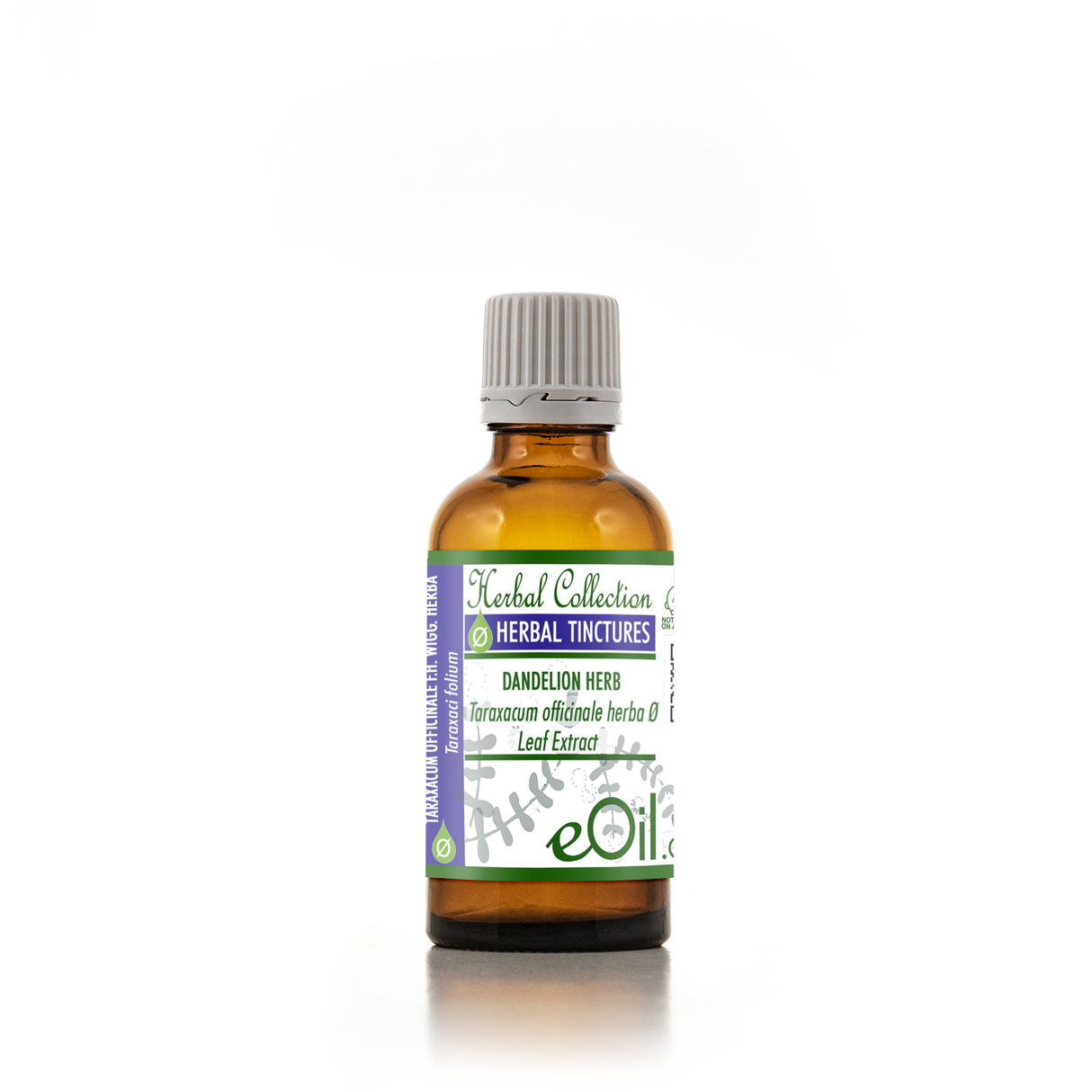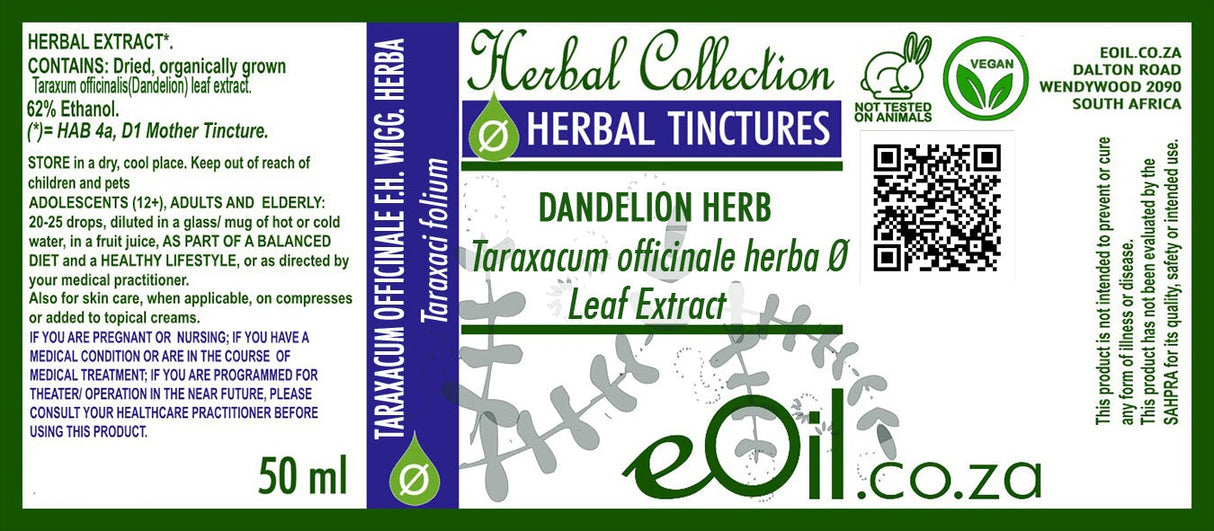Dandelion Herb - Liquid Herbal Extract
Dandelion Herb - Liquid Herbal Extract - 50 ML is backordered and will ship as soon as it is back in stock.
Description
Description
Understanding Mother Tinctures & Glycerines
Dandelion Herb Liquid Herbal Extract (Taraxacum officinale) is crafted from pure, naturally dried dandelion herbs.
Valued for its gentle, earthy character, this alcohol-based liquid is ideal for teas or natural routines focused on botanical wellness.
Free from additives—perfect for creative herbal projects and holistic living
TRADITIONALLY USED FOR
Dandelion (Taraxacum officinale) is a common flowering plant found in many parts of the world.
It is often considered a weed, but dandelion has been used for centuries in traditional medicine for its various health benefits.
The entire plant, including its leaves, flowers, and roots, can be used for medicinal purposes.
Traditional Uses:
- Liver health: Dandelion has been traditionally used to support liver function, detoxification, and overall liver health.
- Digestive aid: Dandelion has been used to stimulate appetite, improve digestion, and alleviate symptoms of indigestion, bloating, and constipation.
- Diuretic: Dandelion has been used as a natural diuretic to help reduce water retention and promote healthy kidney function.
- Skin conditions: Dandelion has been used topically to treat various skin conditions, such as acne, eczema, and psoriasis.
Properties:
- Diuretic: Dandelion has natural diuretic properties, which can help increase urine production and eliminate excess water from the body.
- Antioxidant: Dandelion is rich in antioxidants, including vitamins A, C, and E, as well as flavonoids, which help protect the body from oxidative damage.
- Anti-inflammatory: Dandelion contains compounds with anti-inflammatory properties, which may help reduce inflammation and associated pain.
- Hepatoprotective: Dandelion has been shown to have hepatoprotective effects, helping to protect the liver from damage and support its function.
It's important to note that more research is needed to confirm some of these benefits, and individual results may vary. Always consult with a healthcare professional before using dandelion or any herbal supplement, especially if you are pregnant, breastfeeding, have allergies, or are taking any medications. Ingesting dandelion may also interfere with certain medications, such as diuretics, blood thinners, and blood pressure medications, so it's crucial to speak with your healthcare provider before incorporating it into your routine.
Dandelion Herb vs. Dandelion Root: Similarities & Differences Similarities
- Both dandelion herb (leaves/flowers/stems) and dandelion root come from the Taraxacum officinale plant and are rich in antioxidants, vitamins, and minerals.
- Both have traditional and research-backed uses for supporting digestion, liver health, detoxification, and mild inflammation.
- The tincture (liquid extract) can be made from either root, herb (leaves/flowers/stems), or a combination (full plant), with the solvent (often alcohol) extracting the key active compounds for rapid absorption in the body.
Differences:
| Aspect | Dandelion Herb (Leaf/Flower/Stem) | Dandelion Root |
|---|---|---|
| Main Uses | - Natural diuretic (reduces water retention, supports kidney/bladder) | - Liver detox and support |
| - Supports lymphatic, urinary, and blood systems | - Promotes bile flow, stimulates digestion | |
| - Supplies potassium and vitamin K | - Acts as a mild laxative, relieves constipation, supports gut microbiome | |
| Key Nutrients | - Rich in vitamins A, C, K, calcium, magnesium, potassium, folate, fiber | - High in inulin (prebiotic fiber), compounds beneficial for gut flora |
| Antioxidants | - Polyphenols, beta-carotene (mainly in leaf/flower) | - Polyphenols, beta-carotene, inulin, chlorogenic acid |
| Focus | - Kidney function, water balance, mild hypertension, mild detox | - Liver cleansing, bile production, deeper detox, bowel regulation |
| Profile | - Gentler; good for ongoing support, mild clearing, light detox | - Stronger acting for sluggish liver, chronic skin/digestive issues |
| Taste | - Green, slightly bitter, “salad-like” | - Earthy, more bitter, coffee-like (especially when roasted) |
| Contraindications | - Allergy to daisy family, potassium-sparing diuretics | - Same as above, plus gallstones, blocked bile ducts, acute gallbladder inflammation |
| Common Preparations | - Fresh/dried herb (in salads/teas/tinctures), capsules, tinctures | - Root as tea, tincture, roasted “coffee,” capsules |
Tincture Notes:
- Both root and herb tinctures are available and offer more concentrated, quicker-acting doses than teas. Root tinctures are preferred for liver/digestion, herb tinctures for kidney/water retention, and blends for all-around detox.
- Dosing is similar for both: typical adult dose 2–5 ml (0.5–1 tsp) 2–3 times daily (always check specific product guidance).
Summary:
- Use dandelion herb if your main needs are gentle cleansing, diuretic effects, or mineral support.
- Use dandelion root if targeting deep liver/gut detox, constipation, or skin problems related to liver sluggishness.
- Tinctures from either (or both) offer a fast, potent delivery and are popular in modern herbal routines.
Both are safe for most healthy adults, but consult a professional if you have gallbladder issues, are allergic to related plants, or take specific medications (diuretics, blood thinners, lithium, etc.).
INFORMATION
Source : http://www.wikiphyto.org/wiki/Pissenlit
Reference on http://www.wikiphyto.org
Translation in English by Google Translate (go to the page of the source linked | on Chrome cellphones go on the 3 dots on the top right and select translate in your preferred language | on laptop right click your mouse and select option translate when hoovering on the page
plant name
Dandelion, Dent de lion , Dent-de-lion , dandelion (English)
International Latin denomination
Taraxacum campylodes GE Haglund = Taraxacum officinale Weber (= Taraxacum dens leonis Desf.)
botanical family
Asteraceae
Description and habitat
- Perennial herb with a strong taproot
- Basal leaves arranged in a rosette and deeply divided into unequal triangular and hooked lobes
- Hollow stems, solitary heads of golden yellow flowers, all ligulate
- Achenes surmounted by fine silky tufts
- Common in wet meadows and fields
History and tradition
- The leaves make very good spring salads
- In traditional medicine, used in nocturnal enuresis, contrary to its diuretic effect
- Bitterness is due to the presence of sesquiterpene lactones
- Folk medicine used it for anemia and "to purify the blood"
Parts used
- Root harvested in autumn
- Leaves harvested in spring
Dosage forms available
- Whole plant tincture
- Root EPS
- Dry extract
- Fluid extract
- Various specialties
Usual dosages
- Infusion 4-10 g of drug 3 times a day
- Or 30 grams of roots per liter of water, boil for a few minutes, infuse for 1/2 hour. Drink a liter a day, 10 days a month. Discontinuous cures (like all "drainers")
Composition
Main components of the plant
- Fructose , maximum content in spring (18%)
- Inulin , maximum content in autumn (40%) with reserve proteins [1]
- Sesquiterpene lactones formerly called “ taraxacin ”
- Pentacyclic triterpene alcohols : taraxasterol = alpha-lactucerol , pseudotaraxasterol = isolactucerol , arnidiol , faradiol , beta-amyrin , cycloartenol
- Flavonoids : luteoloside , cosmosioside , apigenin , quercetol glucosides , luteolin-rutinoside
- Sterols : sitosterol , stigmasterol , ( taraxasterol and pseudotaraxasterol )
- Phenolic acids : caffeic acid , p-coumaric acid , ferulic acid , protocatechuic acid , para-hydroxyphenylacetic acid , para-hydroxybenzoic acid , cichoric acid, caffeoylquinic acid isomers [2] , [3] , [4]
- Coumarins : scopoletol , esculetol , umbelliferone
- Beta-fructofuranosidases (producers of fructo-oligosaccharides ) [5]
- Potassium (4.5% in whole plant, 2.5% in root)
- Vitamin C and beta-carotene in the leaves
- The heavy metal content of the leaves is highly dependent on the region of origin [6]
Main components of buds or young shoots
Main components of essential oil
Properties
Plant properties
- Choleretic and cholagogue, eupeptic
- OrRequirement, increases gastric secretion
- Diuretic [7] , effect probably linked to high potassium content [8] , even by leaves and by inulin
- Causes weight loss [9] , anti-obesity by inhibiting pancreatic lipase [10]
- Mild laxative, “depurative”, prebiotic
- Detoxifying, induces phase 2 enzymes , dramatic increase (244% of control) in activity of phase II detoxifying enzyme UDP-glucuronosyl transferase in rats [11]
- Hypolipidemic, antioxidant, protects against oxidative stress responsible for atherosclerosis [12]
- Hepatoprotector [13]
- Anti-inflammatory ( taraxasterol ) [14] , antioxidant [15] , regulates muscle cell viability, anti-inflammatory and muscle analgesic [16]
- Anti-hyperglycemic, anticoagulant [17]
- Immunostimulant, induces neutrophil migration, splenic lymphocyte proliferation and phagocytosis [18] , nitric oxide (NO) production [19]
- Antineoplastic [20] ( lupeol ), anti-carcinogenic [21] , cytotoxic activity on Hep G2 liver cancer cells [22] , and on MCF-7/AZ prostate and breast cancer cells [23]
- Anti-angiogenic, anti-inflammatory, anti-nociceptive activity by inhibition of NO production and COX-2 expression [24]
- Restores NO production and TNF-alpha secretion by interferon-gamma primed mouse peritoneal macrophages [25]
- Anti-anemic, increases the number of red blood cells and hemoglobin in mice [26]
- Moderate antidiabetic [27]
- Protective against certain pancreatitis [28]
- Promising anti-HIV properties [29]
- Rich in inulin like Chicory Cichorium intybus , another Asteraceae
- The flowers are potent antioxidants against reactive oxygen species and nitric oxide [30] , [31]
Bud properties
Properties of essential oil
Directions
Indications of the whole plant (phytotherapy)
- Prevention of cholelithiasis
- Enzymatic stimulation of the liver and kidneys
- Obesity
- Cholecystopathy
- Insufficient digestion of lipids
- Obesity
- Gout, rheumatic diseases
- Eczema and skin diseases
- Spring and/or autumn “detox” cures
- Support for heavy and/or prolonged treatments (chemos, etc.); pay attention to interactions with cytochromes P450, provide therapeutic windows, respect protocols
- In homeopathy:
- Depapillated tongue “in geography map”, jaundice or subicterus
Indications of the bud (gemmotherapy)
Specific indications of essential oil (aromatherapy)
Known or suspected mode of action
- Inulin is an osmotic diuretic: filtered by the renal glomerulus, it increases the osmotic pressure of the tubular fluid
- Sesquiterpene lactones are the "bitter principles" of yesteryear, they have a hepatic and renal enzymatic stimulating action
Usual formulations
- Dandelion root decoction:
- Dandelion root ( Taraxacum dens leonis ): two tablespoons for one liter of water. Boil for a few minutes, infuse for 1/2 hour. Drink a liter a day, 10 days a month.
Regulations
- French Pharmacopoeia list A (root, leaf, aerial part)
Possible side effects and precautions for use
- No known toxicity
- Interaction with cytochromes P450, decreased activity of CYP1A2 and CYP2E in hepatic microsomes of rats fed dandelion, no observed alteration in CYP2D and CYP3A activities
- Contraindications: pregnancy, lactation, heart and kidney disease
- Anaphylactic reactions and possible contact allergies [33]
Bibliographic references
- Go↑ David R. Cyr, J. Derek Bewley. Proteins in the roots of the perennial weeds chicory (Cichorium intybus L.) and dandelion (Taraxacum officinale Weber) are associated with overwintering. Planta, Volume 182, Number 3, 370-37. PMID 24197187
- Go↑ Katrin Schütz, Dietmar R. Kammerer, Reinhold Carle, Andreas Schieber. Characterization of phenolic acids and flavonoids in dandelion (Taraxacum officinale WEB. ex WIGG.) root and herb by high-performance liquid chromatography/electrospray ionization mass spectrometry. Rapid Communications in Mass Spectrometry, Volume 19, Issue 2, pages 179–186, 30 January 2005. PMID 15593267
- Go↑ Christine A. Williams, Fiona Goldstone, Jenny Greenham. Flavonoids, cinnamic acids and coumarins from the different tissues and medicinal preparations of Taraxacum officinale. Phytochemistry, Volume 42, Issue 1, May 1996, Pages 121-127. PMID 8728061
- Go↑ W. Kisiel, B. Barszcz. Further sesquiterpenoids and phenolics from Taraxacum officinale. Fitoterapia, Volume 71, Issue 3, 1 June 2000, Pages 269-273. PMID 10844166
- Go↑ PP Rutherford, AC Deacon. β-Fructofuranosidases from roots of dandelion (Taraxacum officinale Weber). Biochem J. 1972 February; 126(3): 569–573.
- Go↑ R Djingova, I Kuleff, I Penev, B Sansoni. Bromine, copper, manganese and lead content of the leaves of Taraxacum officinale (dandelion). Science of The Total Environment, Volume 50, April 1986, Pages 197-208
- Go↑ Bevin A. Clare, Richard S. Conroy, Kevin Spelman. The Diuretic Effect in Human Subjects of an Extract of Taraxacum officinale Folium over a Single Day. J Altern Complement Med. Aug 2009; 15(8): 929–934. doi:10.1089/acm.2008.0152 [1]
- Go↑ Hook, Ingrid & A, McGee & Henman, Martin. (1993). Evaluation of Dandelion for Diuretic Activity and Variation in Potassium Content. International Journal of Pharmacocognosy. 31. 29-34. 10.3109/13880209309082914.
- Go↑ Elisabeth Racz-Kotilla, G. Racz, Ana Solomon. The action of Taraxacum officinale extracts on the body weight and diuresis of laboratory animals. PlantaMed 1974; 26(7): 212-217
- Go↑ Zhang J, Kang MJ, Kim MJ, Kim ME, Song JH, Lee YM, Kim JI. Pancreatic lipase inhibitory activity of taraxacum officinale in vitro and in vivo. Nutr Res Pract. 2008 Winter;2(4):200-3. PMID 20016719 full text
- Go↑ Maliakal PP, Wanwimolruk S. Effect of herbal teas on hepatic drug metabolizing enzymes in rats. J Pharm Pharmacol. 2001 Oct;53(10):1323-9. PMID 11697539
- Go↑ Choi UK, Lee OH, Yim JH, Cho CW, Rhee YK, Lim SI, Kim YC. Hypolipidemic and antioxidant effects of dandelion (Taraxacum officinale) root and leaf on cholesterol-fed rabbits. Int J Mol Sci. 2010 Jan 6;11(1):67-78. doi: 10.3390/ijms11010067. PMID 20162002
- Go↑ Singh, A., Malhotra, S., & Subban, R. (2008). Dandelion (Taraxacum officinale)-hepatoprotective herb with therapeutic potential. Pharmacognosy Reviews, 2(3), 163.
- Go↑ Wang Y, Li GH, Liu XY, Xu L, Wang SS, Zhang XM. In vivo anti-inflammatory effects of taraxasterol against animal models. Afr J Tradit Complement Altern Med. 2016 Nov 23;14(1):43-51. doi: 10.21010/ajtcam.v14i1.6. eCollection 2017. PMID 28480383
- Go↑ González-Castejón M, Visioli F, Rodriguez-Casado A. Diverse biological activities of dandelion. Nutr Rev. 2012 Sep;70(9):534-47. doi: 10.1111/j.1753-4887.2012.00509.x. PMID 22946853
- Go↑ Liu Q, Zhao H, Gao Y, Meng Y, Zhao XX, Pan SN. Effects of Dandelion Extract on the Proliferation of Rat Skeletal Muscle Cells and the Inhibition of a Lipopolysaccharide-Induced Inflammatory Reaction. Chin Med J (Engl). 2018 Jul 20;131(14):1724-1731. doi: 10.4103/0366-6999.235878. PMID 29998893
- Go↑ Schütz K, Carle R, Schieber A. Taraxacum—A review on its phytochemical and pharmacological profile. Journal of Ethnopharmacology. Vol 107, 3, 2006, pp 313-323. PMID 16950583 [2]
- Go↑ J Kim, G Choi, H Hwang, H Ku, C Choi, G Jung, B So. Characterization of immunostimulatory activities of fractions obtained from Taraxacum officinale. PlantaMed 2010; 76 - P421 DOI: 10.1055/s-0030-1264719
- Go↑ Kim HM, Oh CH, Chung CK. Activation of inducible nitric oxide synthase by Taraxacum officinale in mouse peritoneal macrophages. Gen Pharmacol. 1999 Jun;32(6):683-8. PMID 10401993
- Go↑ Faria TC, Nascimento, CCHC, Vasconcelos, SDD De., Stephens, PRS, Saranraj, P., Barreto, A. S, Diré, GF*, Literature Review on The Biological Effects of Taraxacum Officinale Plant In Therapy, Asian Journal of Pharmaceutical Research and Development. 2019; 7(3):94-99. DOI: http://dx.doi.org/10.22270/ajprd.v7i3.502
- Go↑ Hata K, Ishikawa K, Hori K, Konishi T. Differentiation-inducing activity of lupeol, a lupane-type triterpene from Chinese dandelion root (Hokouei-kon), on a mouse melanoma cell line. Biol Pharm Bull. 2000 Aug;23(8):962-7. PMID 10963304
- Go↑ Hyun-Na Koo, Seung-Heon Hong, Bong-Keun Song, Cheorl-Ho Kim, Young-Hyun Yoo, Hyung-Min Kim. Taraxacum officinale induces cytotoxicity through TNF-α and IL-1α secretion in Hep G2 cells. Life Sciences, Volume 74, Issue 9, 16 January 2004, Pages 1149-1157. PMID 14687655
- Go↑ Sigstedt SC, Hooten CJ, Callewaert MC, Jenkins AR, Romero AE, Pullin MJ, Kornienko A, Lowrey TK, Slambrouck SV, Steelant WF. Evaluation of aqueous extracts of Taraxacum officinale on growth and invasion of breast and prostate cancer cells. Int J Oncol. 2008 May;32(5):1085-90. PMID 18425335
- Go↑ Hye-Jin Jeona, Hyun-Jung Kangb, Hyun-Joo Junga, Young-Sook Kanga, Chang-Jin Limb, Young-Myeong Kim, Eun-Hee Park. Anti-inflammatory activity of Taraxacum officinale. Journal of Ethnopharmacology, Volume 115, Issue 1, 4 January 2008, Pages 82-88. PMID 17949929
- Go↑ Kim HM, Lee EH, Shin TY, Lee KN, Lee JS. Taraxacum officinale restores inhibition of nitric oxide production by cadmium in mouse peritoneal macrophages. Immunopharmacol Immunotoxicol. 1998 May;20(2):283-97. PMID 9653673
- Go↑ Modaresi M, Resalatpour N. The Effect of Taraxacum officinale Hydroalcoholic Extract on Blood Cells in Mice. AdvHematol. 2012;2012:653412. doi: 10.1155/2012/653412. PMID 22844289
- Go↑ Wirngo FE, Lambert MN, Jeppesen PB. The Physiological Effects of Dandelion (Taraxacum Officinale) in Type 2 Diabetes. Rev Diabetes Stud. 2016 Summer-Fall;13(2-3):113-131. doi: 10.1900/RDS.2016.13.113. PMID 28012278
- Go↑ Sang-Wan Seo, Hyun-Na Koo, Hyo-Jin An, Kang-Beom Kwon, Byung-Cheal Lim, Eun-A Seo, Do-Gon Ryu, Goo Moon, Hong-Yeoul Kim, Hyung-Min Kim, Seung -Heon Hong. Taraxacum officinale protects against cholecystokinin-induced acute pancreatitis in rats. World Journal of Gastroenterology 2005;11(4):597-599 [3]
- Go↑ Han H, He W, Wang W, Gao B. Inhibitory effect of aqueous dandelion extract on HIV-1 replication and reverse transcriptase activity. BMC Complementary and Alternative Medicine 2011, 11:112 (14 November 2011) Abstract [4] , full text [5]
- Go↑ C. Hu, DD Kitts. Dandelion (Taraxacum officinale) flower extract suppresses both reactive oxygen species and nitric oxide and prevents lipid oxidation in vitro. Phytomedicine, Volume 12, Issue 8, 2 August 2005, Pages 588-597
- Go↑ Chun Hu, David D. Kitts. Antioxidant, Prooxidant, and Cytotoxic Activities of Solvent-Fractionated Dandelion (Taraxacum officinale) Flower Extracts in Vitro. J. Agric. Food Chem., 2003, 51 (1), pp 301–310
- Go↑ Agarwal SC, Crook JR, Pepper CB. Herbal remedies - how safe are they? A case report of polymorphic ventricular tachycardia/ventricular fibrillation induced by herbal medication used for obesity. Int J Cardiol. 2006 Jan 13;106(2):260-1. PMID 16321701
- Go↑ Assessment report on Taraxacum officinale Weber ex Wigg., radix cum herba. European Medicine Agency, Committee on Herbal Medicinal Products (HMPC), 12 November 2009, EMA/HMPC/212897/2008 full text
- Sweeney B, Vora M, Ulbricht C, Basch E. Evidence-based systematic review of dandelion (Taraxacum officinale) by natural standard research collaboration. J Herb Pharmacother. 2005;5(1):79-93. PMID 16093238
CAUTION
Store in a cool, dry place, away from light. Keep tightly closed, away from the reach of Children and pets.
Do not exceed the daily dose.
This product is not intended to prevent or cure any form of illness or disease.
If you are pregnant or nursing ; If you have a medical condition or are in the course of medical treatment ; If you are programmed for theater/operation in the near future, please consult your healthcare practitioner before using this product.
This product cannot replace a varied and balanced diet and a healthy lifestyle.
This product has not been evaluated by the SAHPRA for its quality, safety or intended use.





